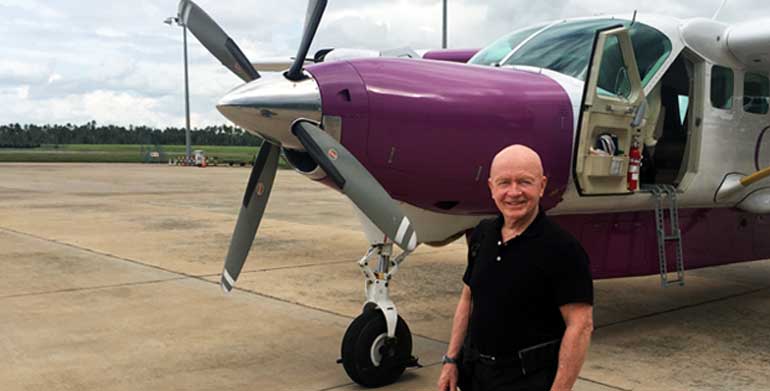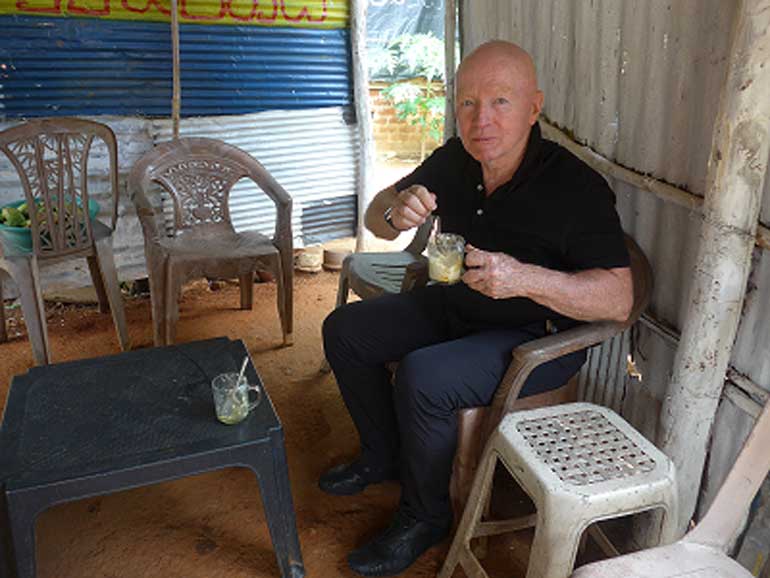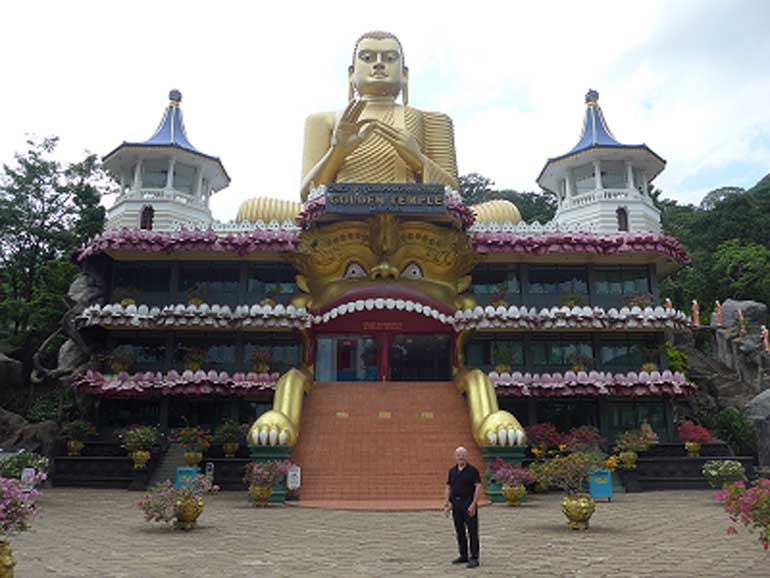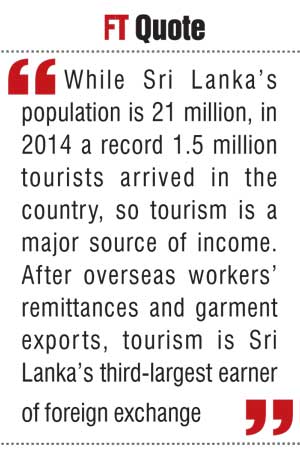Thursday Mar 13, 2025
Thursday Mar 13, 2025
Monday, 21 December 2015 00:00 - - {{hitsCtrl.values.hits}}


Enjoying local yogurt with treacle in Sri Lanka
 Visiting the Golden Temple in Dambulla, Sri Lanka
Visiting the Golden Temple in Dambulla, Sri Lanka
Sri Lanka has a fascinating history with one of the first written references to the island made in the ancient Indian epic Ramayana, which mentions how Lanka was created by the divine sculptor for the Lord of Wealth.
The first recorded kingdom, the Anuradhapura Kingdom, was established in 380 BC. Buddhism arrived in the country around 250 BC and continues to be the dominant religion, affecting many areas of life in Sri Lanka today. I recently visited the country again and, as always, was impressed by its beauty, its dedication to the environment and its friendly people.
I encourage travellers to check out Sri Lanka, which has much to offer tourists including warm weather, expansive beaches and an interesting heritage with many cultural attractions. My team and I weren’t there to simply soak up the sun and sights—we toured the country with an eye on potential investment opportunities.
In this first part of a two-part blog, I explore the country, examine the infrastructure and talk to people on the ground—and in the air.
To Colombo and back
We first arrived in Colombo, the seaside capital of Sri Lanka, but stayed only one night, as we had to depart the next morning for Trincomalee by way of a Cessna single-engine plane. Finding the exact location of the small airport adjacent to the new international airport was a problem—our takeoff point was a military airfield down the road—but after a few frantic phone calls to find the airport we were on our way.
I expected a bumpy ride on the small plane but the pilots avoided the clouds and the plane was low enough for us to get a wonderful view of the countryside. The plane stopped at Sigiriya to drop off four Spanish tourists before proceeding to Trincomalee.
At Trincomalee, we noticed a number of beach resorts catering to budget travellers and local tourists on company-sponsored tours. We thought the tourist potential for that part of the country was excellent because of its long beaches.
While Sri Lanka’s population is 21 million, in 2014 a record 1.5 million tourists arrived in the country, so tourism is a major source of income. After overseas workers’ remittances and garment exports, tourism is Sri Lanka’s third-largest earner of foreign exchange.
The next day we departed by car, heading across the country back to Colombo, giving us the opportunity to check out the road conditions. The road turned out to be very good—a smooth, two-lane highway. We stopped along the route to indulge in some ox milk yogurt with treacle, a form of honey made from coconut juice (a local specialty).
It was a good example of how low-income people supplement their farming income on the tourist trade. As we drove on, our driver said that during the long war with the Liberation Tigers of Tamil Eelam (LTTE) that finally ended in 2009, the LTTE remotely set and detonated many bombs along the road in order to kill government troops.
We noticed roofless houses where the military found the LTTE and bombed them. Along the way we also saw large reservoirs created under kings of past eras to irrigate large tracts of land for sugar cane and rice.
Matale
In the town of Matale, we noticed large and opulent homes. In the middle of the town stood a very elaborate Hindu temple done in a riot of colours with hundreds of statutes. The town had become rich from the spice trade, particularly in cinnamon. Although the majority of the country’s citizens subscribe to the Buddhist faith, there are a significant number of Hindus and Muslims in addition to small clusters of Christians.
The drive from Trincomalee to Sigiriya took two hours. Sigiriya (Lion Rock) is an amazing ancient palace on a massive rock column about 200 meters high located in the centre of the country. The gardens are particularly important and are among the oldest landscaped gardens in the world.
According to legend, in 477 AD, King Kasyapa selected the site for his new capital and built his palace on the top of the rock, decorating its sides with colourful frescos of dancing ladies, and carving out pools on the top to gather and store water.
Halfway up the side of the rock he built a gateway in the form of a giant lion. It is reputed to be one of the best preserved examples of ancient urban planning and is the most visited historic site in Sri Lanka. It is said that Kasyapa murdered his father and usurped the throne from the rightful heir, his brother Mugalan. Preparing for the inevitable return of his brother, Kasyapa built the palace on the summit, which seemed impregnable. But when the final battle took place on the plains below, Kasyapa’s elephant took a turn that looked to his army like he was retreating, and this led to his army abandoning him. Too proud to surrender, he committed suicide by falling on his sword, according to legend.
It was an hour’s drive from Sigiriya to the Dambulla Buddha caves (and the Golden Temple of Dambulla). This was an important stop since it underlined the significance of Buddhism in the country, certainly as evidenced by the numerous pilgrims, dressed in white and holding flowers, who climbed 160 meters of stairs with us to reach the caves and pay their respects to the 153 Buddha statues and exquisite paintings related to Gautama Buddha’s life.
Our trip onward from Dambulla to Kandy, the former capital and second-largest city after Colombo, took about two hours. High up in the middle of the country, Kandy is known by film buffs as the location where parts of the 1984 film, Indiana Jones and the Temple of Doom were filmed, but it also has an interesting ancient history.
Temple of the Tooth Relic

A major tourist stop, its main attraction is the Temple of the Tooth Relic, one of the most sacred places of worship in the Buddhist world. Between 1815 and 1948, Kandy was a British colonial city and traces of British influence can clearly be seen all over, most particularly in a large church right next to the palace holding the Tooth Relic. Also there was a beautiful building in the town housing the Salvation Army. The city was the last stronghold of the final Sri Lankan king and repelled invasions by the Portuguese and Dutch up until the 1800s until the British finally succeeded in 1815. After buying a ticket and taking off our shoes, we visited the Royal Palace and the impressive gold- and marble-encrusted temple inside the fortress wall. Inside the temple, many people were sitting on the floor listening to Buddhist priests chanting and praying. Interestingly, inside the temple were lithographs on the walls depicting various British colonial governors visiting the temple and paying respects to Buddhist monks. After visiting the temple, as we walked away toward the city’s center, I noticed a statue depicting a Sinhalese nationalist holding high a Sri Lanka flag and dragging a British flag on the ground, a monument to those who fought against the British colonial masters.
Many years ago on a prior visit to the country, I witnessed the impressive processions during the ‘Festival of the Sacred Tooth’ where the tooth relic of the Buddha is carried on a richly decorated elephant and taken on a grand procession through the city streets, led by traditional dancers and drummers. On this visit, we toured the shopping district, including a rather new mall where—in contrast to my prior visit to the area—a rock band was playing for the entertainment of shoppers.
Our team proceeded from Kandy to Negombo on the west coast. The roads were good, but quite crowded. Negombo is called ‘Little Rome’ because the majority of the population is Roman Catholic, as evidenced by the many Roman Catholic churches. Many of the churches are in the highly ornate Portuguese style, reflecting past Portuguese use of the port for the cinnamon trade.
Today, it is a beach resort town of about 120,000 people conveniently only 35 kilometres north of Colombo and near the international airport. There are some nice beach hotels along the long sandy beaches and the usual array of tourist shops on the crowded main street. We had dinner at one of the beach hotels and proceeded on to Colombo. We were encouraged to see lively conversations and commerce taking place in Negombo—and even the congestion—which to us is a sign of growth and opportunity taking place in the country at large.
Environmentally minded tourists in particular will find much to like about Sri Lanka, as Maithripala Sirisena, the country’s president, was formerly an environment minister and has taken a personal interest in the subject.
Killing wildlife is banned in Sri Lanka, and the country has a number of nature reserves. As we travelled through the centre of the country, we saw not only a number of bird species, but also elephants along the road. In their search for food, elephants can often be quite destructive, plowing down fields and even homes.
However, the people respect these majestic creatures, so they are not killed. Companies, however, have been the target of environmental violation crackdowns. We learned that operations at one multinational beverage company’s facility were temporarily halted over suspected waste disposal violations. Some businesses looking to operate in the country may find some of the regulations to be a bit cumbersome, and they may need to adjust. For example, environmental impact assessments may delay certain developers’ projects.
In our view, Sri Lanka should continue to focus on luring international tourists, along with big global brands in hotels, leisure and entertainment. More entertainment and integrated resorts could draw not only eco-minded tourists and budget travellers but also higher-spending tourists in larger numbers, particularly from China and India.
In part two of my tour of Sri Lanka, I’ll explore the political climate—and the climate for potential investors.
Discover Kapruka, the leading online shopping platform in Sri Lanka, where you can conveniently send Gifts and Flowers to your loved ones for any event including Valentine ’s Day. Explore a wide range of popular Shopping Categories on Kapruka, including Toys, Groceries, Electronics, Birthday Cakes, Fruits, Chocolates, Flower Bouquets, Clothing, Watches, Lingerie, Gift Sets and Jewellery. Also if you’re interested in selling with Kapruka, Partner Central by Kapruka is the best solution to start with. Moreover, through Kapruka Global Shop, you can also enjoy the convenience of purchasing products from renowned platforms like Amazon and eBay and have them delivered to Sri Lanka.
Discover Kapruka, the leading online shopping platform in Sri Lanka, where you can conveniently send Gifts and Flowers to your loved ones for any event including Valentine ’s Day. Explore a wide range of popular Shopping Categories on Kapruka, including Toys, Groceries, Electronics, Birthday Cakes, Fruits, Chocolates, Flower Bouquets, Clothing, Watches, Lingerie, Gift Sets and Jewellery. Also if you’re interested in selling with Kapruka, Partner Central by Kapruka is the best solution to start with. Moreover, through Kapruka Global Shop, you can also enjoy the convenience of purchasing products from renowned platforms like Amazon and eBay and have them delivered to Sri Lanka.